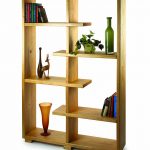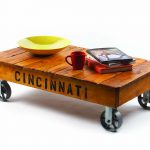We may receive a commission when you use our affiliate links. However, this does not impact our recommendations.
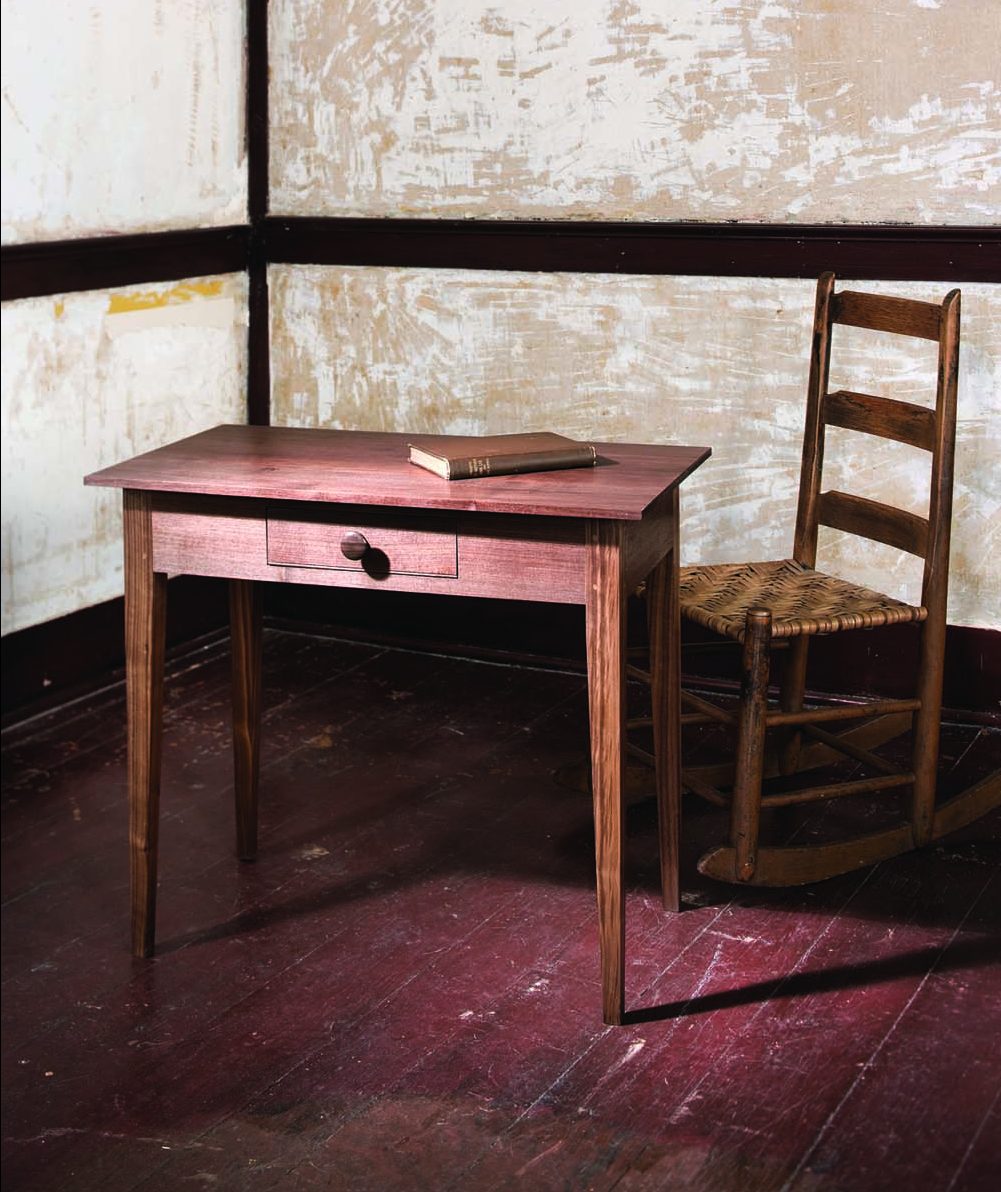
Simply unusual. The original version of this table has some odd features, including its drawer joinery and the way the tabletop is attached to the base (glue and nails). Are these original features?
The first time I encountered this table in the White Water Shaker collection, it was locked in a storeroom with more than a dozen other pieces. To my eye, there was something unusual about it.
Was it the size? It’s 25″ high – a bit shorter than typical. Was it the single drawer surrounded by a solid apron? That’s atypical for Shakers. Or was it something else?
I put my fingers around the front knob and slid the drawer out. And that’s when the mysteries really began. The craftsmanship on the table’s base is impeccable. Tight joints. Neat pins. Clean tapers. And the maker chose excellent wood – the aprons are all quartersawn walnut.
But the drawer was a different story. The drawer had one giant dovetail at each corner, and the half-blind tails at the drawer’s front left a scant 1⁄16” of drawer front. Further, the groove that held the drawer bottom was visible on the ends of the drawer front. That’s usually a no-no.
Then I turned my attention to the tabletop. Unlike the table’s base, the top was flatsawn walnut and was thinner along its edges with an enormously wide rabbet on the underside. The top was glued and nailed to the base.
Several weeks later, I measured the table and all its details. I sat before it and stared for a long time, hoping that I would find the answers to the questions racing through my head.
Was the drawer original? Was it made by a different maker? Was the top a replacement? And what was this table used for? It’s a little big for a side table. And it’s too small and low for a typical worktable. But I liked it, and I resolved to build one to donate to the organization restoring the White Water village – Friends of White Water Shaker Village.
Even today, I don’t have answers to any of these questions, but I do have clues. Senior Art Director Linda Watts visited the South Union Shaker village in Kentucky in 2009 and reported she saw a table like this being used as a washstand with a large washbowl on top. Could the original top of this White Water table have been ruined by water?
The Restoration
I decided to build this table so the wood selection and craftsmanship matched on all the components. That meant a quartersawn walnut top attached with wooden buttons and a more finely dovetailed drawer. This approach troubled me – I don’t like to guess about these things. But as the table came together on my workbench, I convinced myself that I had made the right decision.
On the first day of working on the project, I glued up the slab for the top from three quartersawn walnut boards and set it aside. Then I turned my attention to the aprons, especially the front one.
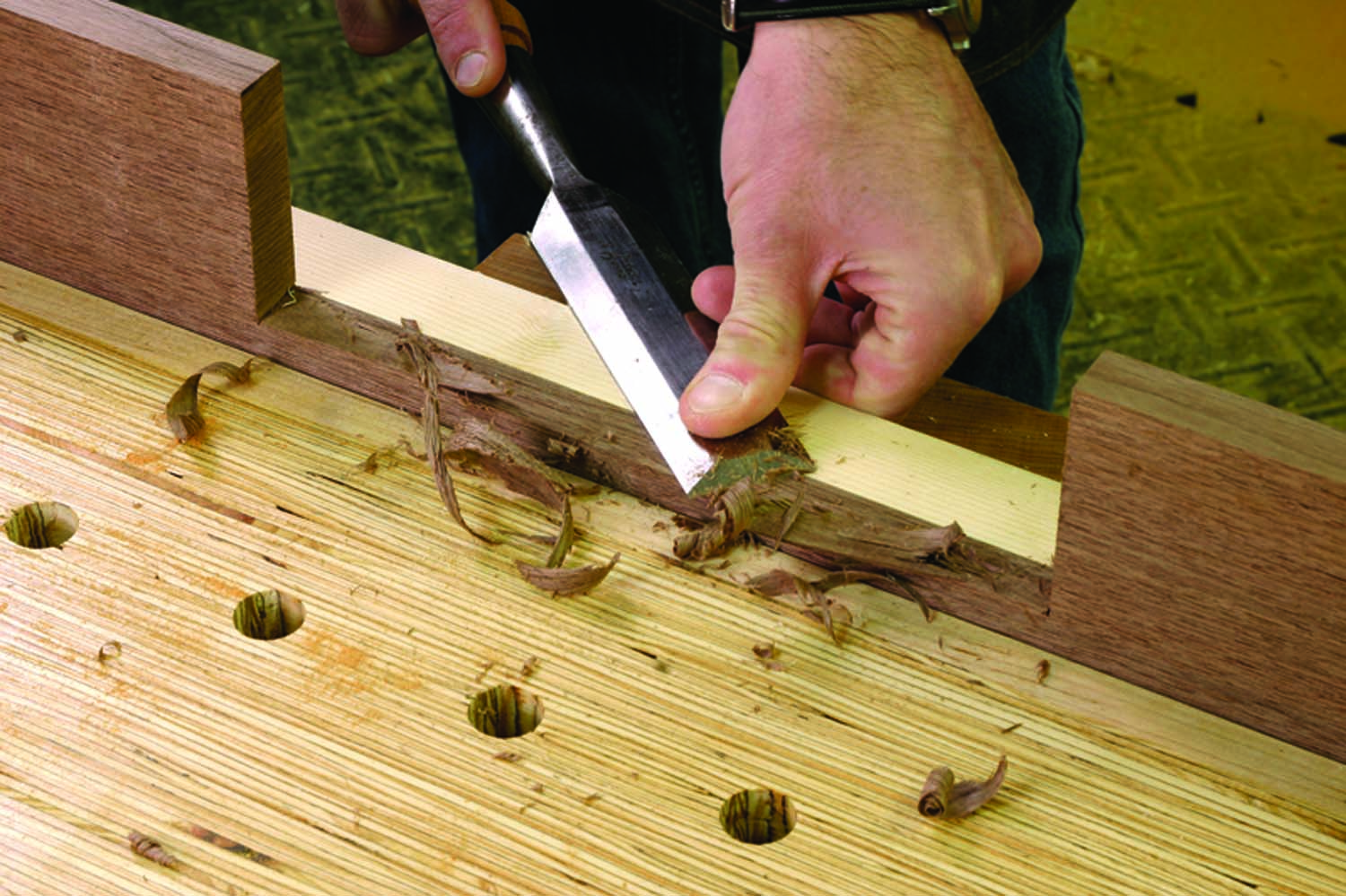
Chisel it clean. To clean up the bottom of the drawer opening, clamp a guide to the apron and use a chisel with its flat face against the guide. Skew the tool to shear the wood and you’ll find the work quite easy.
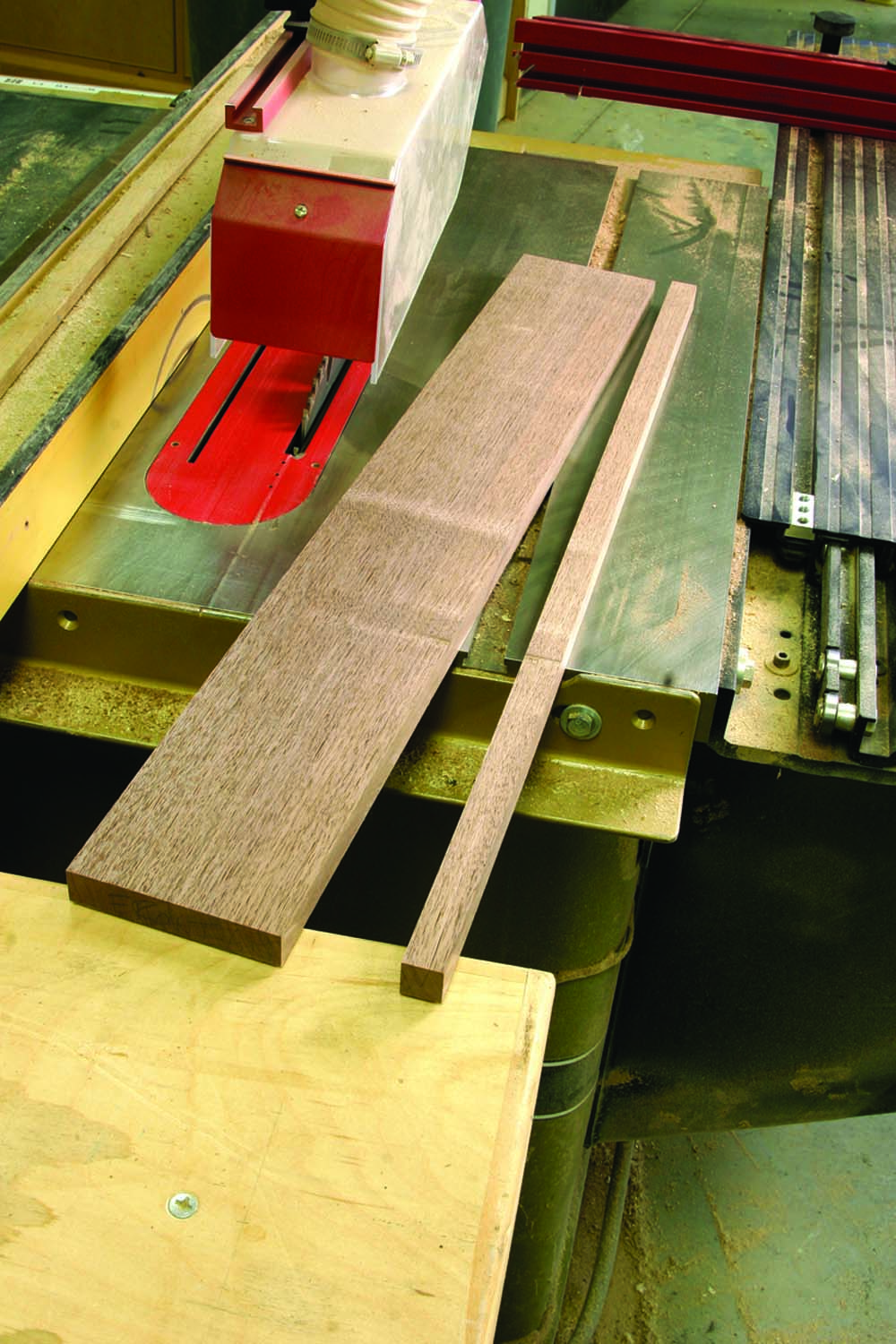
Rip the top rail. I decided to cut my drawer front from the front apron. So I ripped a 5⁄8″-wide strip off the front apron. After cutting the drawer front from the apron, I glued this strip back on.
After inspecting the original, I suspect the drawer opening was cut from the front apron. I decided I wanted the drawer front’s grain to match the apron. So I cut the drawer front from the apron.
Here’s how I did it: I started with an apron piece that was a bit wider than needed. I ripped a 5⁄8” strip from the top of the front apron (this would later become the apron’s top rail). Then I cut the drawer front free from the apron using a backsaw and then a plunge-cutting Japanese saw. Then I glued the 5⁄8” strip back on and I had an apron with a 3″ x 10″ drawer hole in it.
Short & Simple Legs
The legs are 111⁄16” square and taper to 1″ at the floor on the two inside faces. The taper begins 1″ below the apron. When selecting the stock for the legs, look for growth rings that run diagonally from corner to corner. This will ensure the legs look consistent on all four faces.
Mark out the 1⁄4“-wide x 11⁄4“-deep x 4”-long mortises on all four legs. Note that you want the aprons to be set back 1⁄32” from the front face of the legs, so be sure to include that detail in your layout. Excavate the mortises.
Then you can taper the legs. I cut the tapers using a band saw and cleaned up the cuts with a jointer plane (which is safer than most table saw jigs for this operation).
(Almost) Traditional Tenons
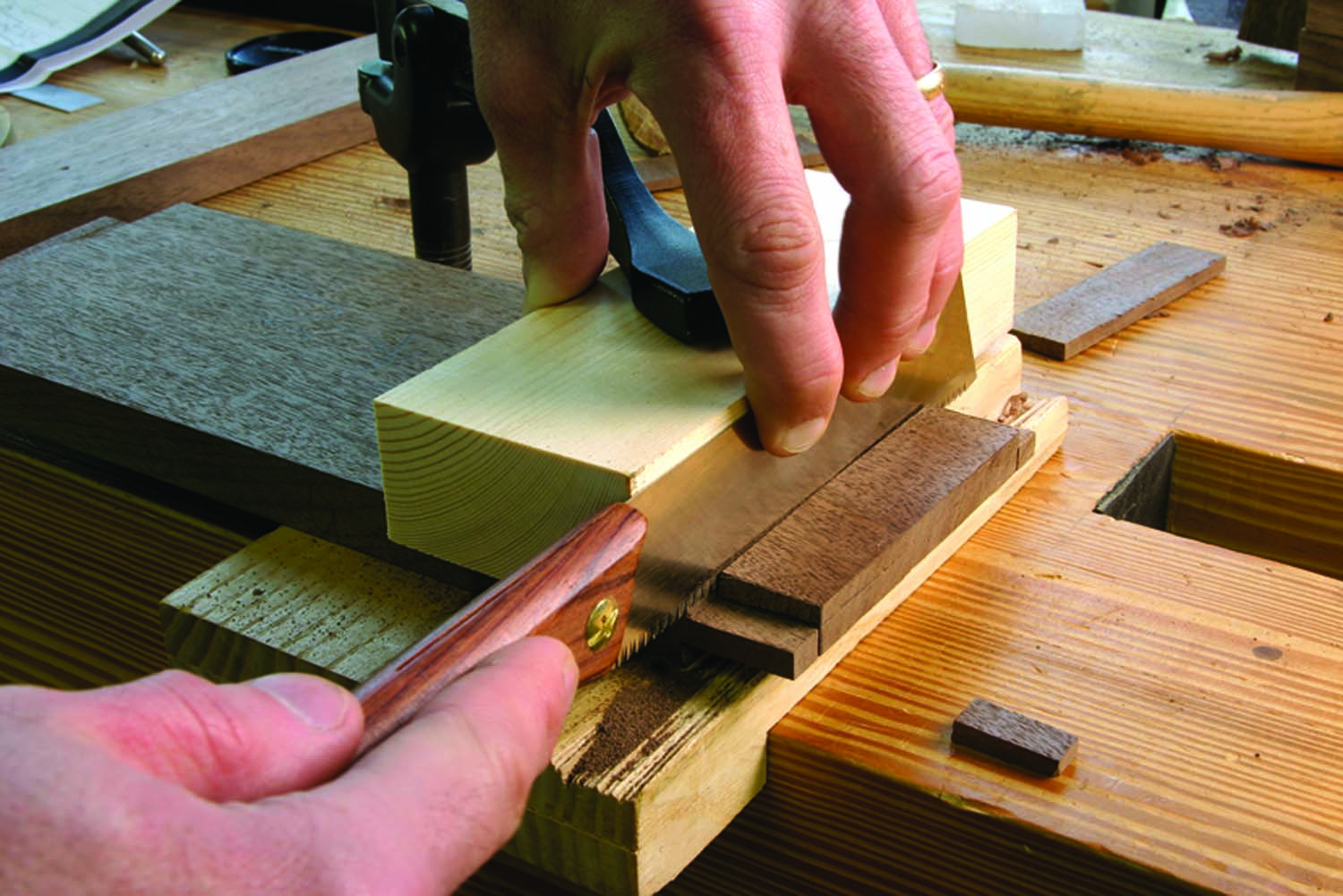
A cheat from the East. To cut the tenons’ face shoulders you can use a scrap of wood to guide a flush-cutting saw. Just make sure the saw has no set and you’ve clamped the guide right on your knifed-in shoulder line.
Then turn your attention to the matching 11⁄8“-long tenons. I sawed mine by hand. It’s a challenge in wide stock such as this, but if you take your time your tenons can fit right from the saw.
I cut the face shoulders of my tenons using a Japanese flush-cutting saw and a block of wood as a guide. I simply clamped the guide on my knife line, pressed the saw against the guide and sawed a perfect shoulder.
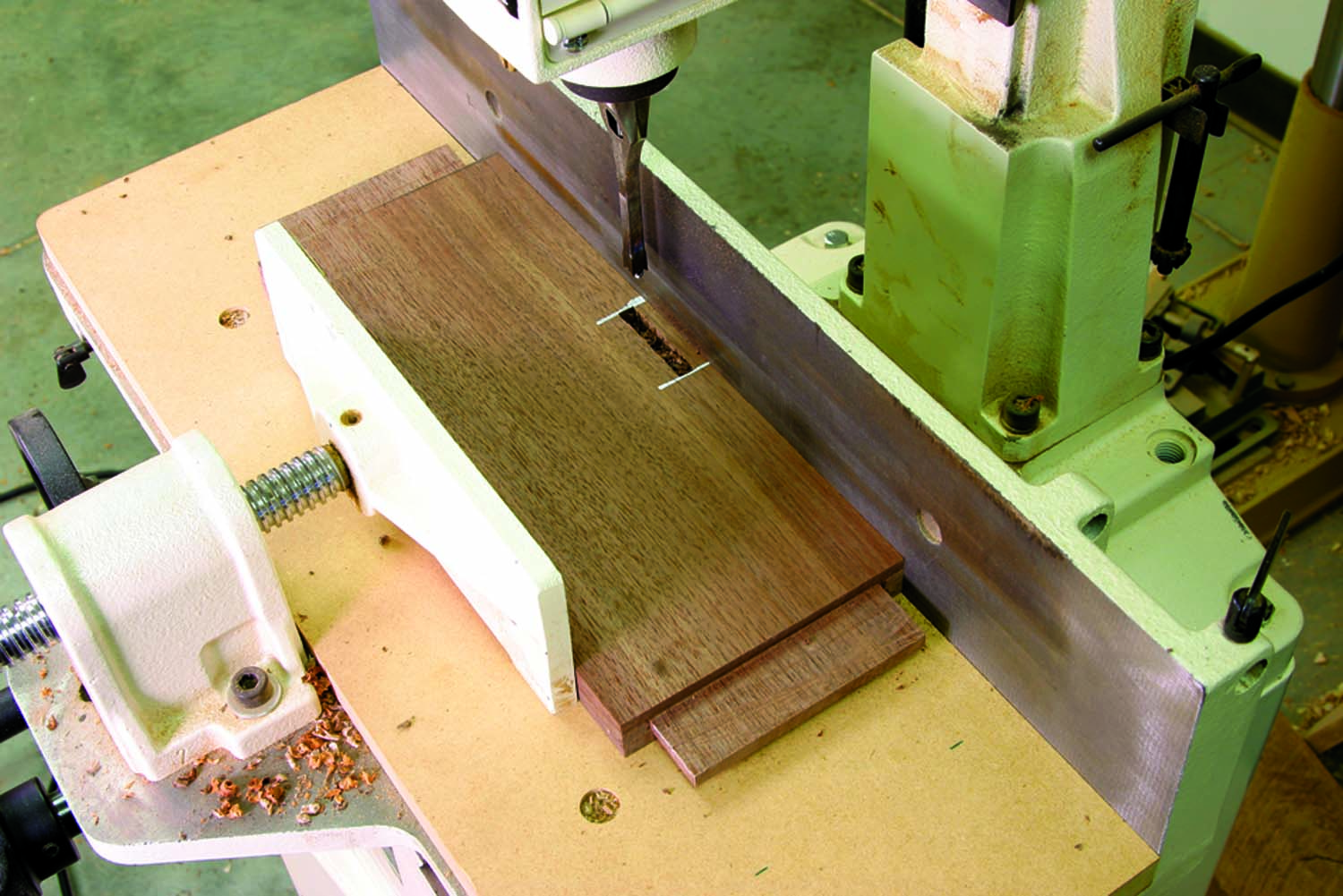
Mortises for buttons. Before assembling the table’s base, you should cut mortises for the buttons that will secure the tabletop to the base. I did these using a mortising machine. The mortises are 1⁄4″ wide, 2″ long and 1⁄2″ deep. Poke one mortise in each end apron and two mortises in the front and back aprons.
I couldn’t bear to nail and glue the top to the table’s base. So I cut mortises in the four aprons that would hold buttons – an excellent way to secure a tabletop to a table base and allow for seasonal movement.
Then I cleaned up the legs and aprons, and prepared them for finishing.




 Gluing & Pegging
Gluing & Pegging
I usually glue up tables in two stages. First I glue the front legs to the front apron and the back legs to the rear apron. Then I peg those tenons and legs together. Next I glue the side aprons to the front and rear assemblies, and I peg those joints.
Pegging joints can be stressful. Here’s how I do it. First I make sure that my pegs and drill bit will play together nicely by making a sample joint. Sometimes pegs can be undersized, which will leave an ugly gap behind.
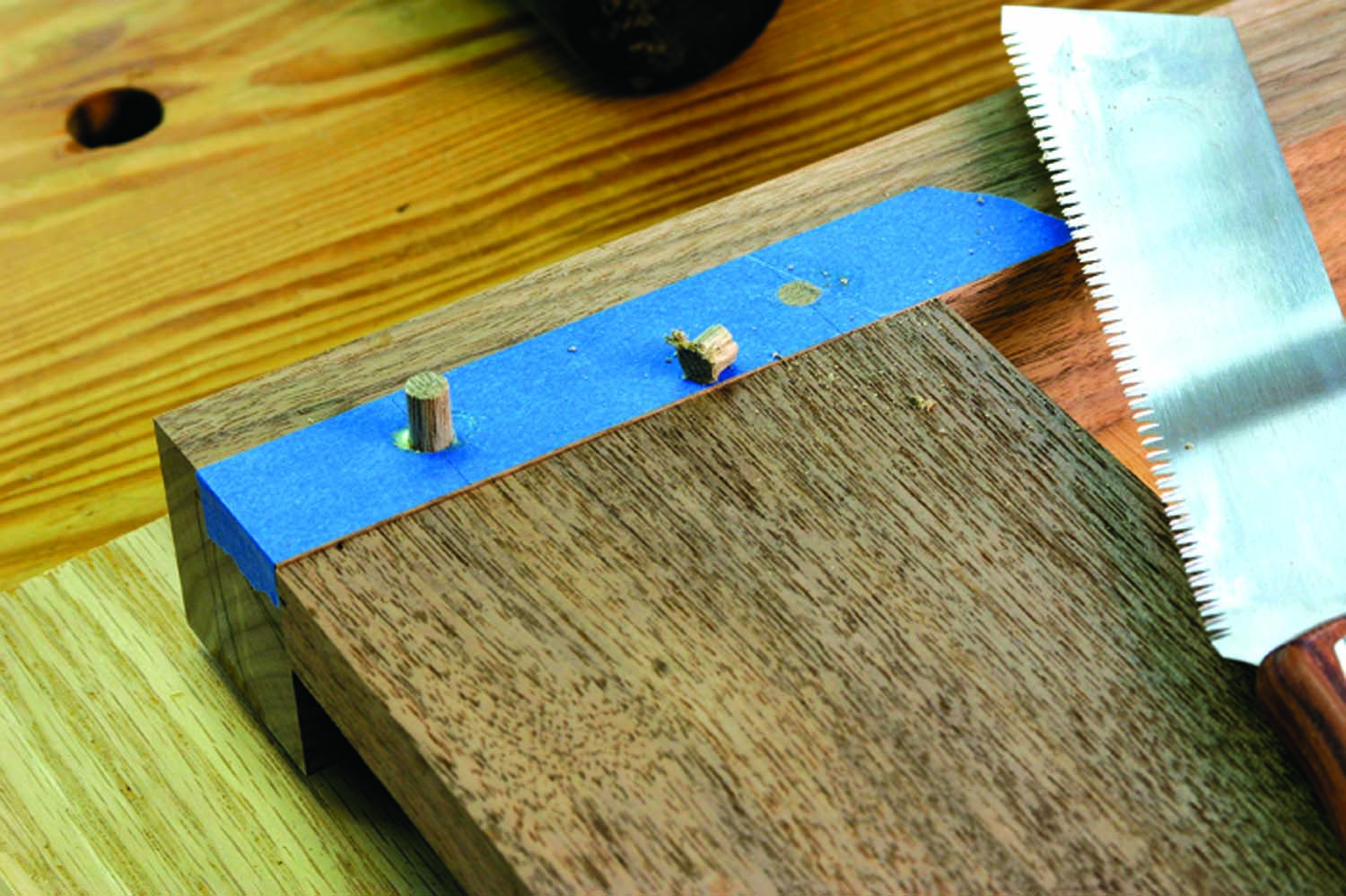
An error barrier. A strip of painter’s tape can protect your finished work from glue squeeze-out and from the teeth of the saw. After you cut the peg flush, remove the tape.
Then I apply painter’s tape over all my joints and lay out where I want my pegs to go on the tape. To drill the hole for the peg, I use a 1⁄4” brad-point bit and run the drill in reverse for a few rotations to score the perimeter of the hole. This little trick reduces tearing at the rim.
Then I drive the 1⁄4” peg in with some glue and cut it flush with a flush-cut saw. The tape protects the wood from the glue and from the occasional wayward saw stroke.
The Raised-panel Tabletop
The tabletop is a bit like a raised panel. The edges are thinned down to 1⁄2” while the center field is left 3⁄4” thick. This wide and shallow rabbet (3″ x 1⁄4“) can be made on the table saw or router table, but it’s also quick work with hand tools. Here’s how.
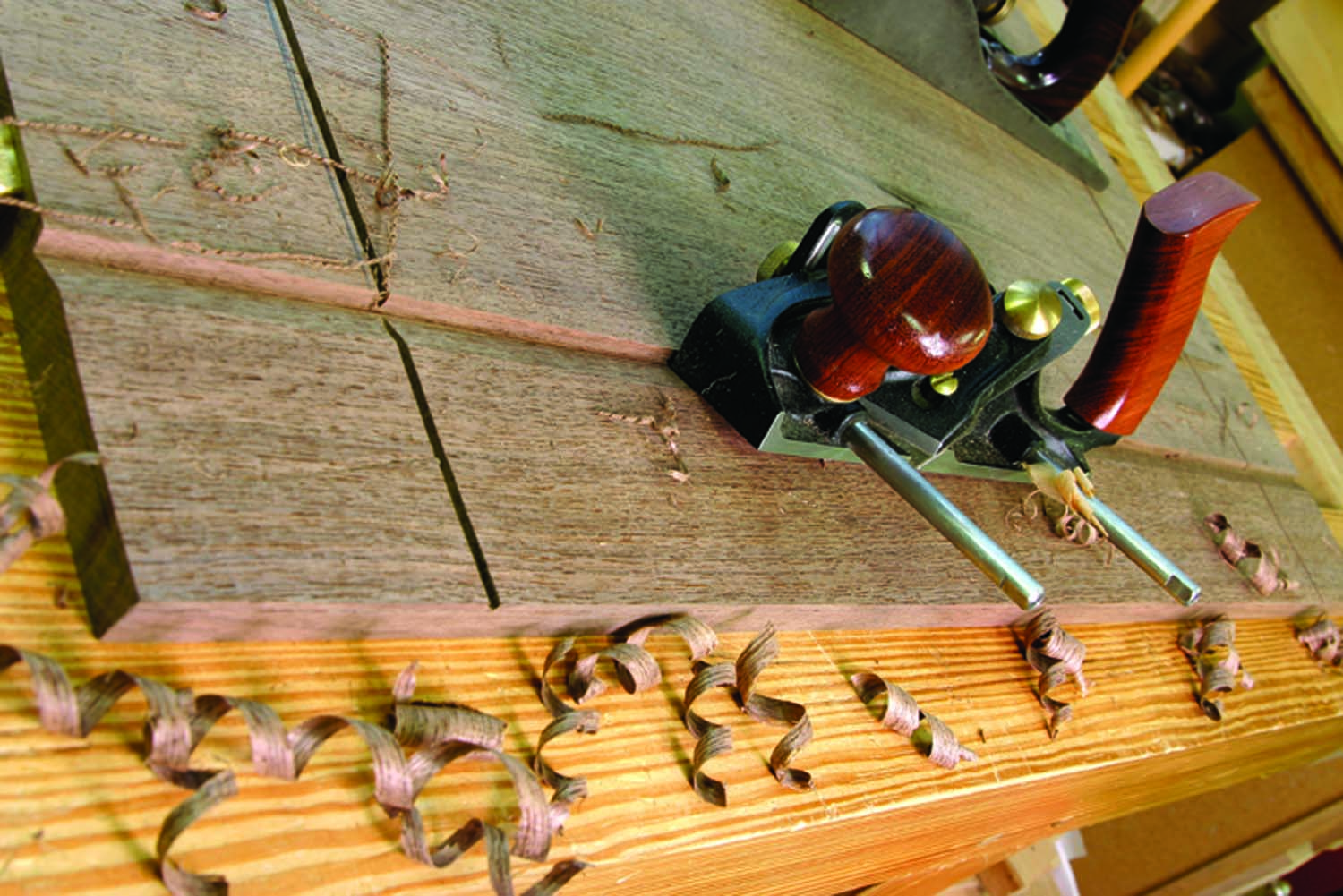
Rabbets without fences. Remove the fence from your rabbet plane and tip the corner of the tool into the kerf as shown. After a few strokes you will reach your finished depth. Stop.
First cut a kerf around the center field of the panel and use a cutting gauge to define the finished 1⁄2” thickness on all four edges. Take a rabbeting plane, tip it about 45° and run it in the kerf. Work the long edges of the tabletop first. After a few strokes, begin tilting the rabbeting plane with each stroke so it’s eventually almost upright. This will create a wide “V.” Work down until the “V” is 1⁄4” deep.
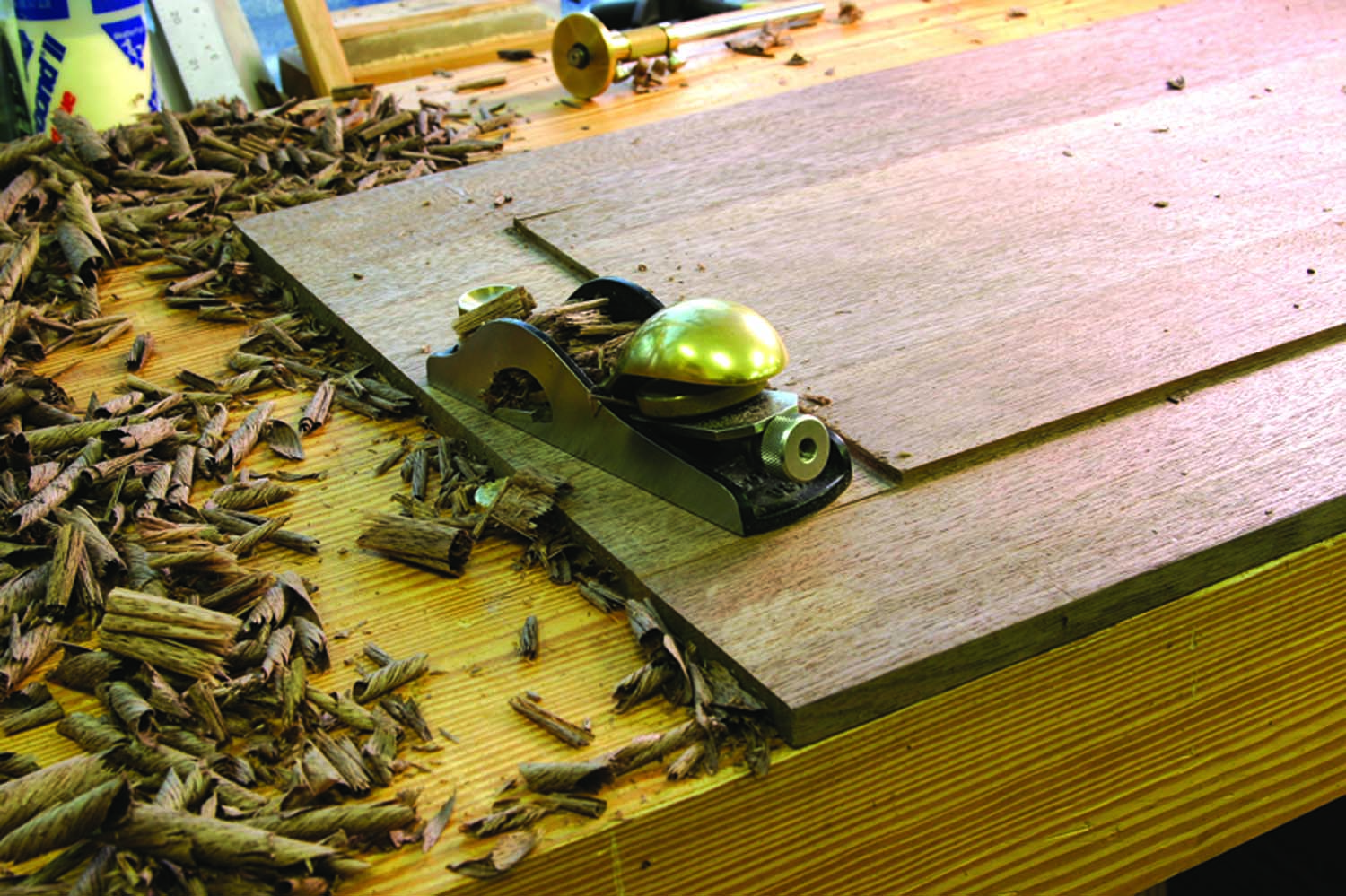
Tidy up the tabletop. A block plane will remove most of the toolmarks from creating this large rabbet. This block plane is a rabbeting block, which allows the tool to get right into the corner.
Then waste away most of the rest of the wood with a fore plane or a scrub plane. Clean up the results with a block plane. After you work the long edges of the tabletop down, work the short edges in the same manner.
Attach the tabletop using shopmade wooden buttons – mine were 1⁄2” x 1″ x 11⁄2“. The buttons have a 1⁄4” x 3⁄4” lip that reaches into the mortises in the aprons. When you screw the buttons to the tabletop, the top stays in place, yet it can move with the seasons. (Note: For the buttons in the long aprons, don’t bottom them out in the mortises.)
Drawers & Their Runners
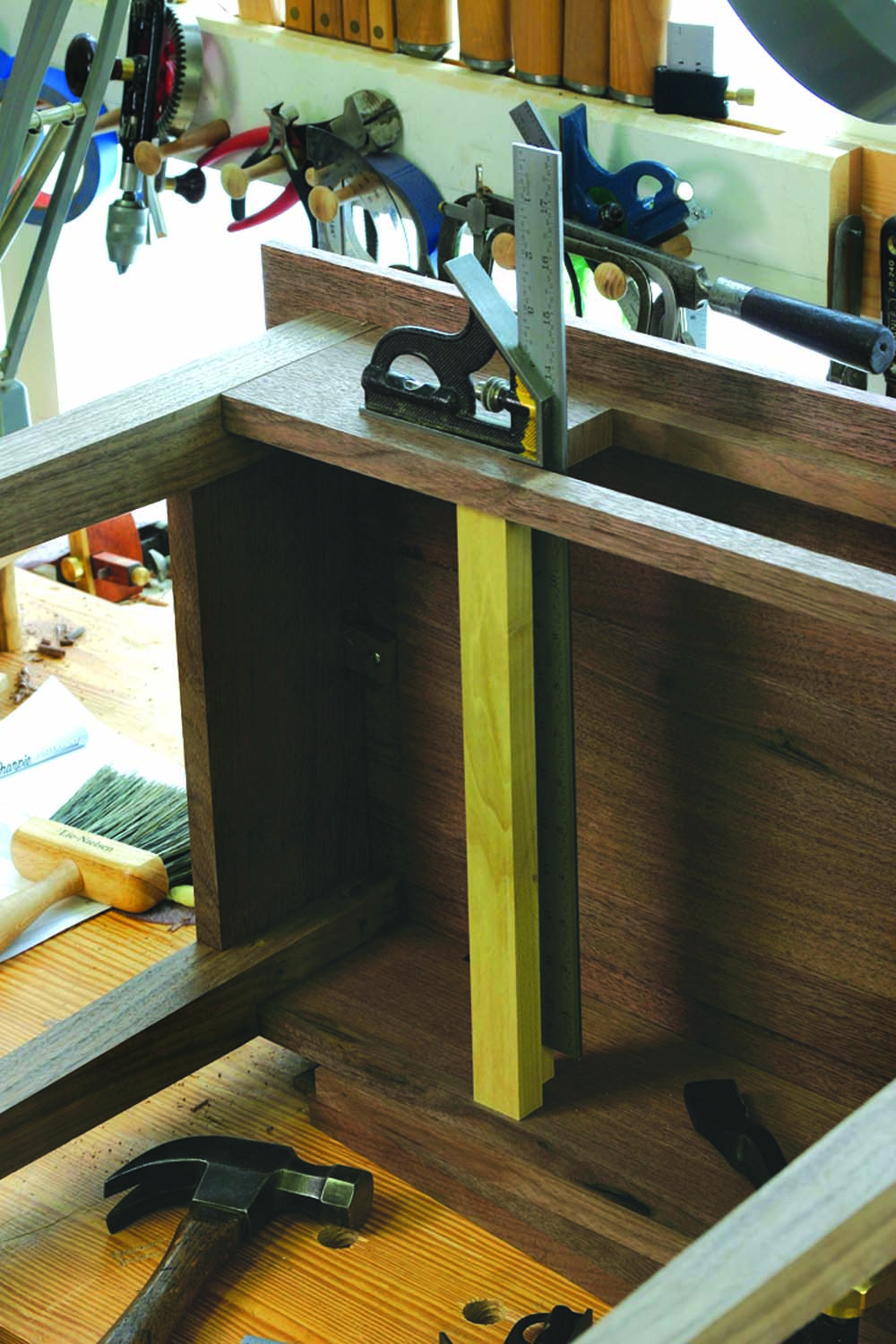
Align your drawer runners. A combination square can help line up your drawer runners and the opening for the drawer. Once everything lines up, drill your pilot holes and nail the runners in place.
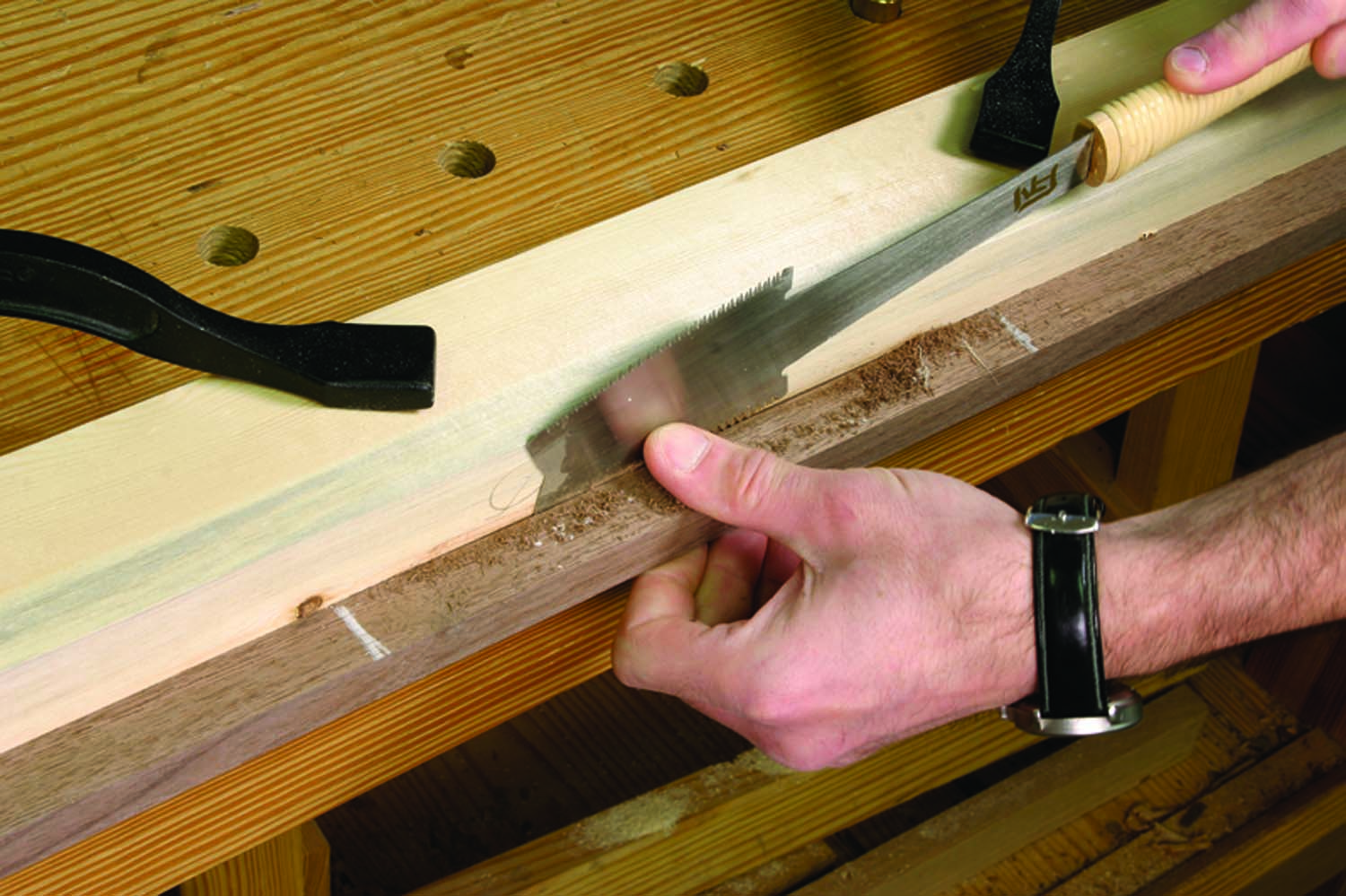
Dive to the bottom. An azebiki nokogiri is a Japanese saw with curved cutting blades (one for rips; the other for crosscuts). Used against a guide, you can start your cut in the middle of the apron and plunge through. This releases the drawer front from the apron.
The table’s two drawer runners are nailed to the front and rear aprons – from the outside of the table. To make the drawer runners, take a long length of 1″ x 15⁄8” wood and cut a 1⁄2” x 7⁄8” rabbet in its long edge. Crosscut the two runners you need and fit them inside the table’s base.
When you have them positioned in the right place, secure them with two cut nails (don’t forget to drill pilot holes for your cut nails).
For the drawer, you can make it like the original, you can build it like I did (with three half-blind tails in the drawer’s front) or build it so it suits you. I took a traditional path with my drawer. The two tails at the two back corners of the drawer are through-dovetails. The bottom is let into a 1⁄4” x 1⁄4” groove in the drawer sides and drawer front. The drawer bottom (like the tabletop) is also like a raised panel and slides in under the drawer’s back, which is 1⁄2” narrower than the drawer sides.
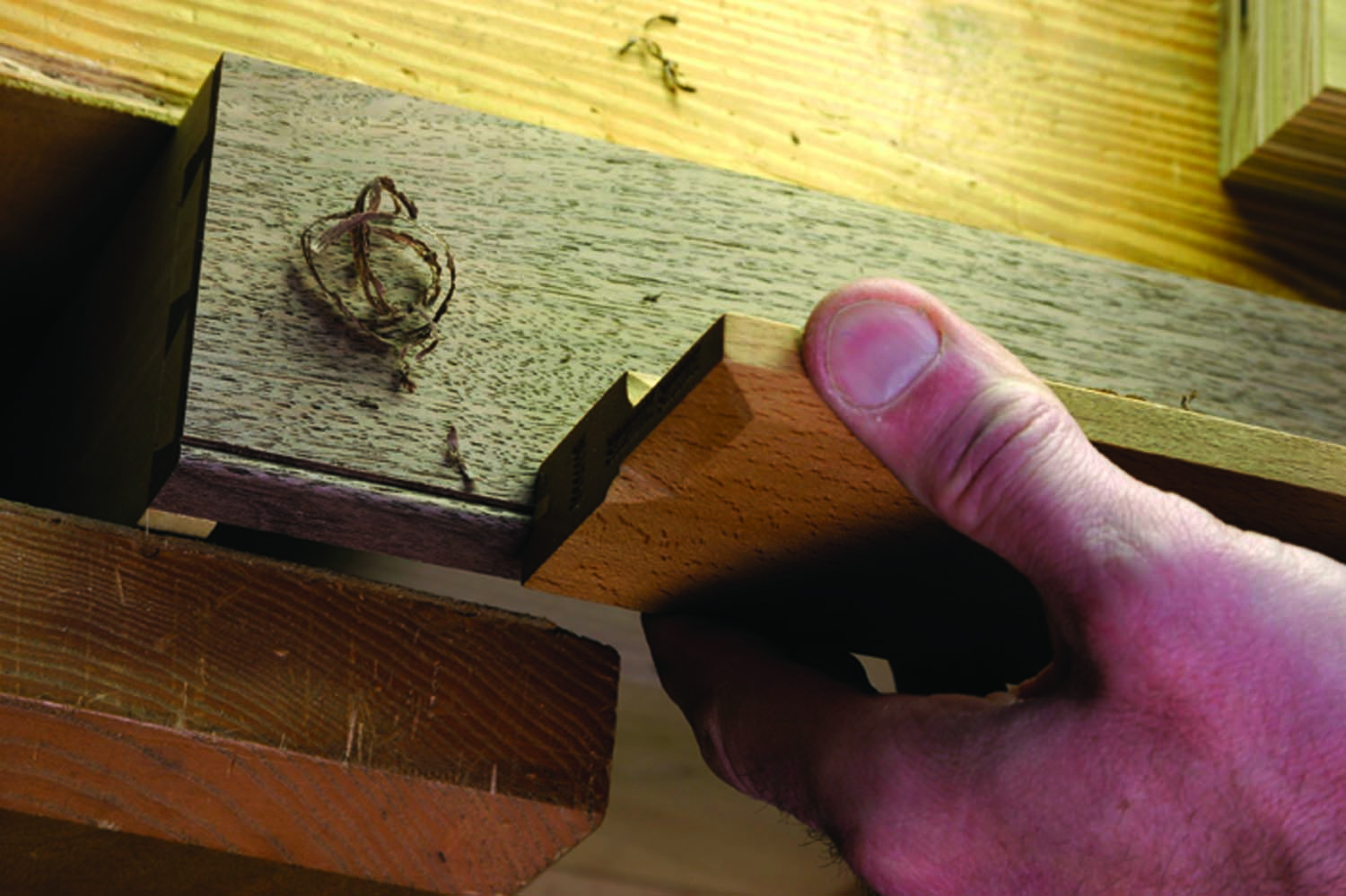
A basic bead. The only decorative detail on the table is a small bead at the top and bottom of the drawer front. You can make this with a moulding plane or scratch stock.
The drawer is finished up with a 3⁄16” bead on the top and bottom edge of the front and a walnut knob. After the drawer slides smoothly, glue in a couple stops to the rear apron to make the drawer fit flush at front.
Finish & Final Thoughts
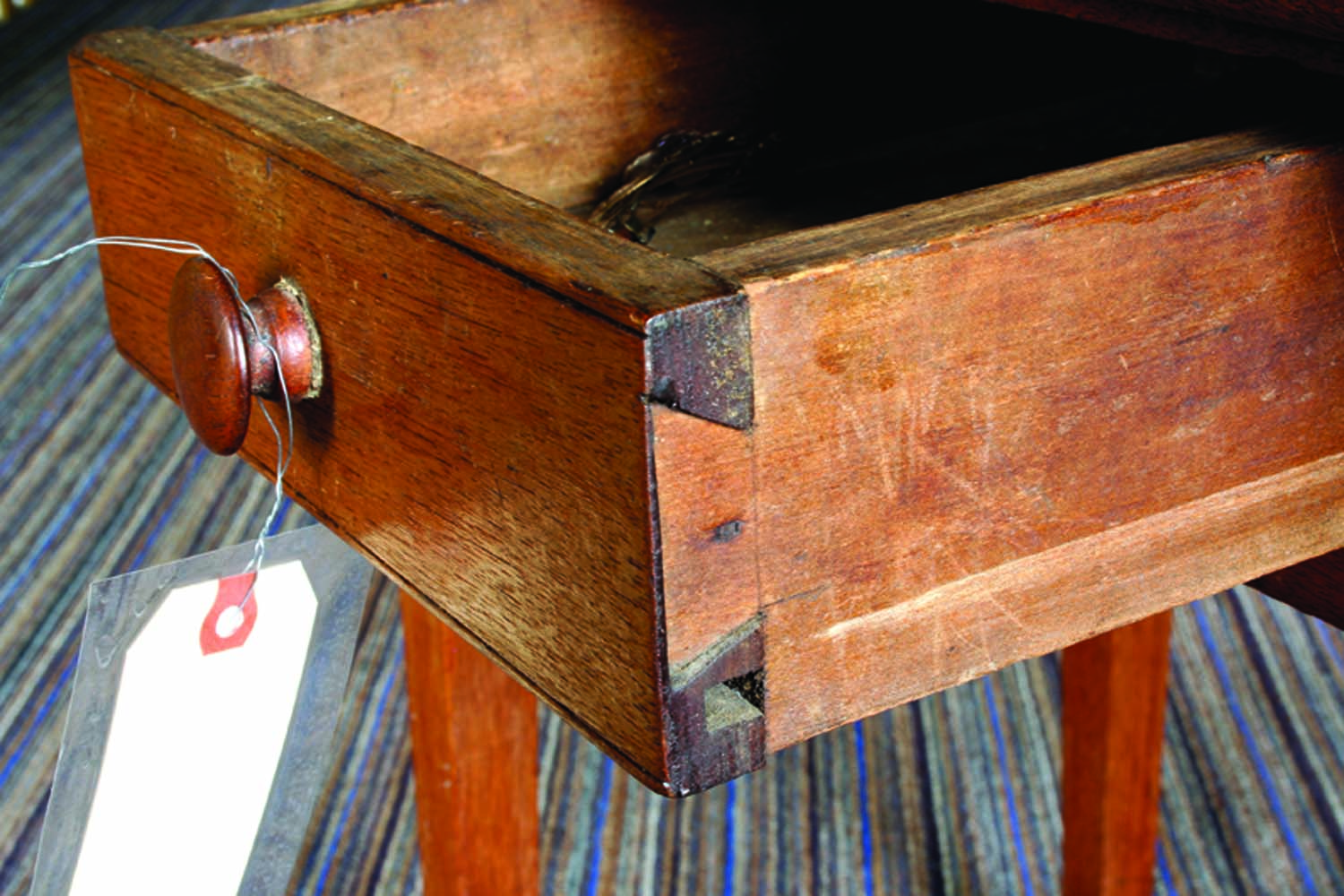
Bigger than most doves. Here’s a shot of the the original drawer. If the maker had planed the drawer front even a little more, the joint could no longer earn the name “blind.”
After breaking all the edges of the table with sandpaper, I added a simple and traditional finish: an oil and varnish blend. The oil gave the walnut warmth; the varnish gave it some protection. Five coats did the trick.
You can buy this finish off the shelf (Watco is one brand). Or you can make it by mixing equal parts alkyd varnish, boiled linseed oil and low-odor mineral spirits (paint thinner). Wipe on thin coats and sand away the dust nibs between coats with #320-grit sandpaper.
As a faithful reproduction, this table is a failure. I changed it too much, from the unusual original drawer to the unconventional way the top was attached on the original. But my changes were sympathetic to the time period (i.e. I didn’t add Blum self-closing drawer slides). So though I can say this table wasn’t the same as the one built in the early 19th century in southern Ohio, I can say that my version wouldn’t look out of place there, either.
Here are some supplies and tools we find essential in our everyday work around the shop. We may receive a commission from sales referred by our links; however, we have carefully selected these products for their usefulness and quality.



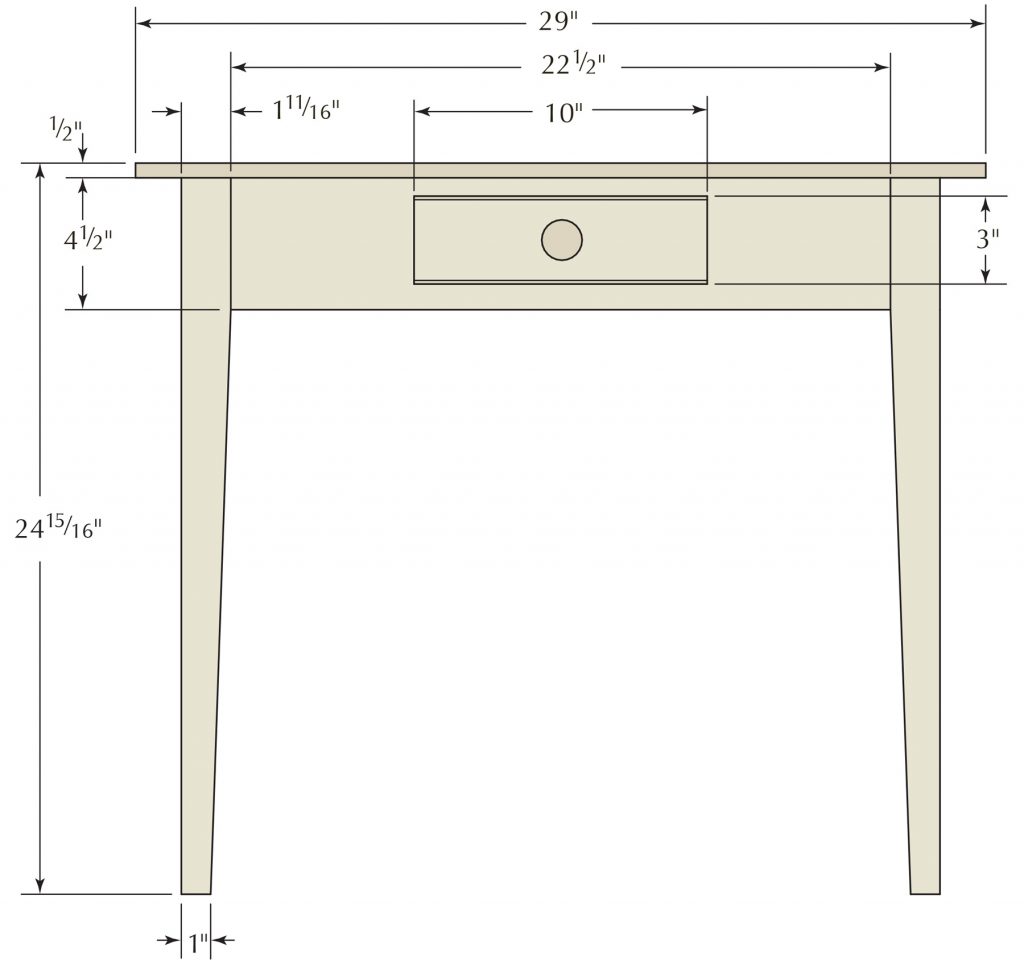
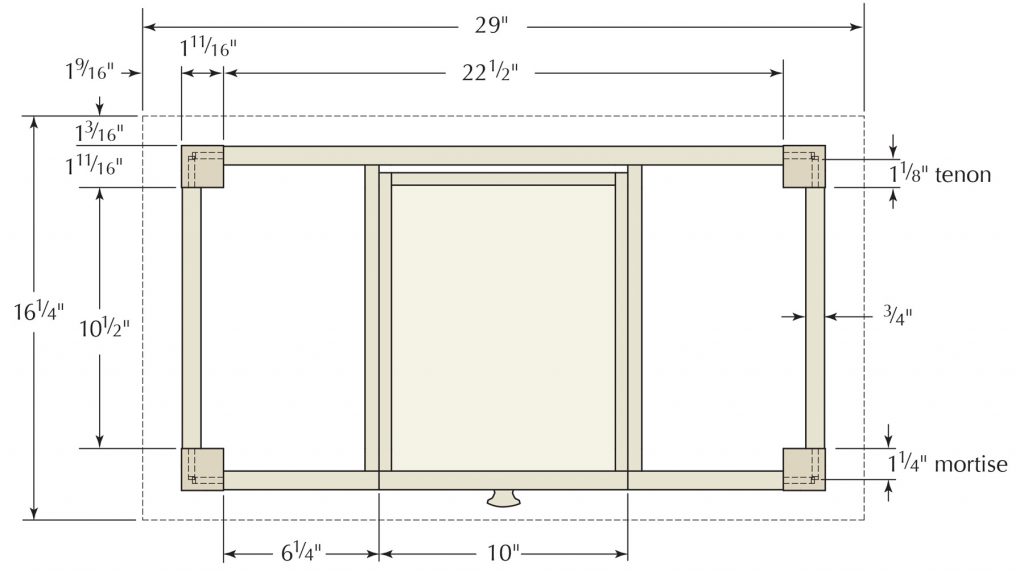
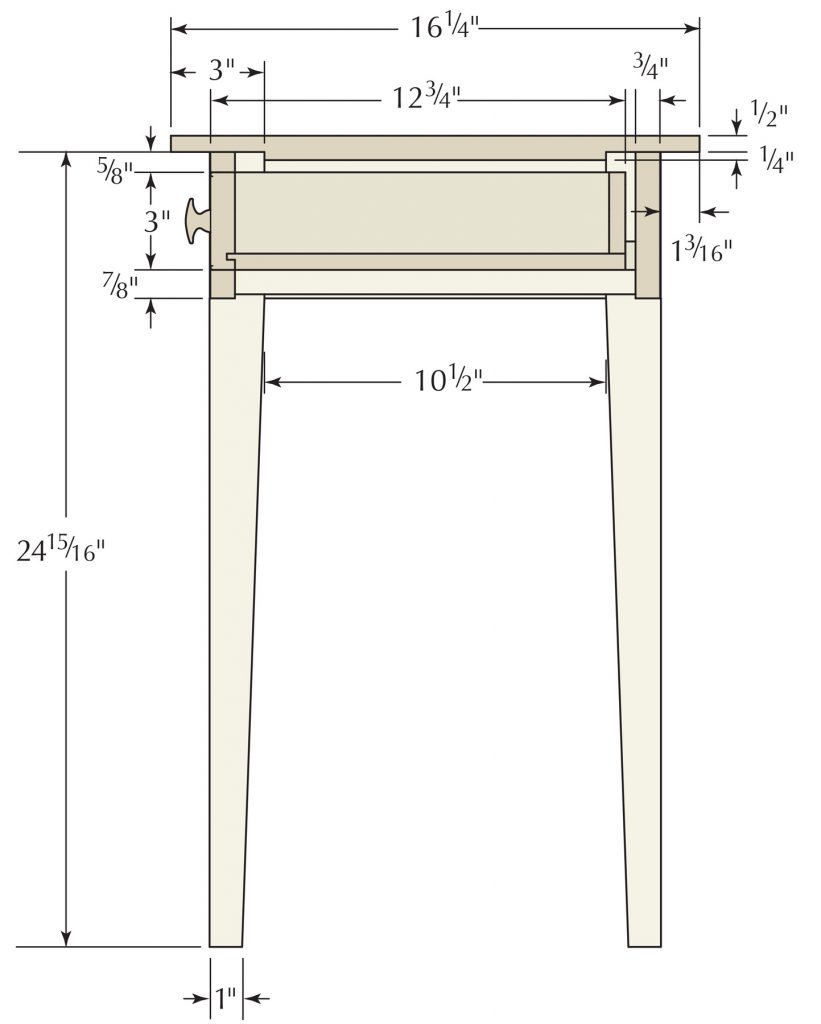
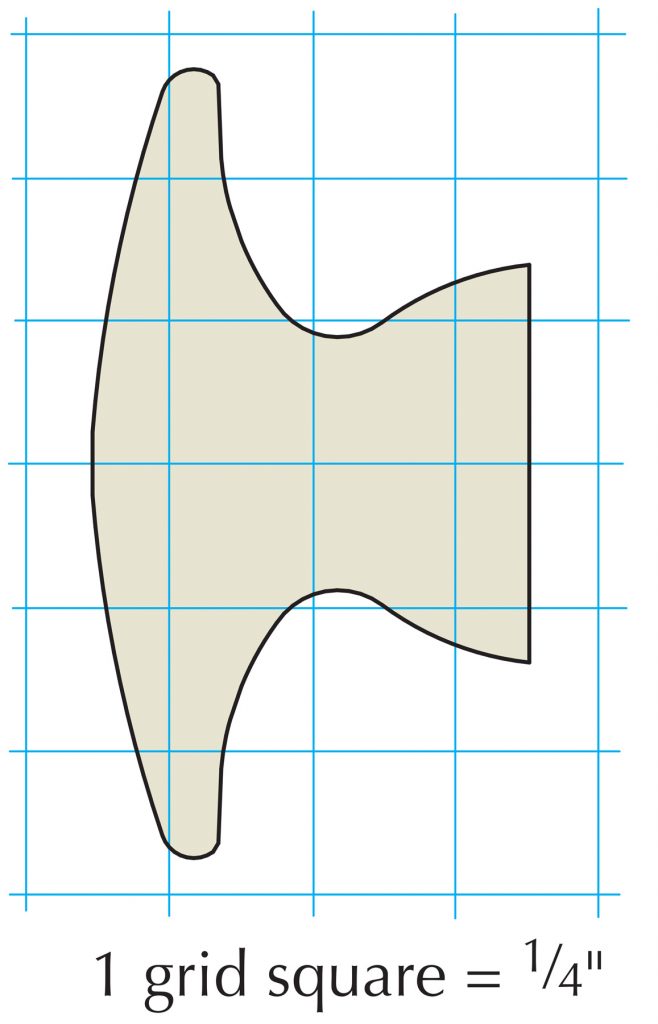
 Gluing & Pegging
Gluing & Pegging



